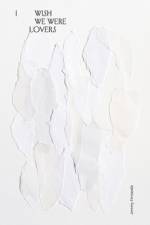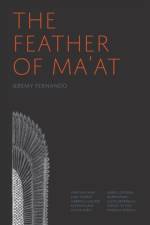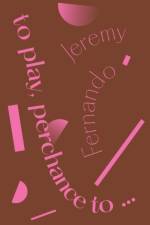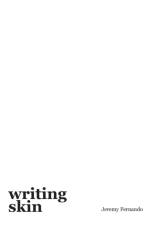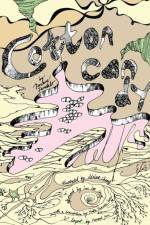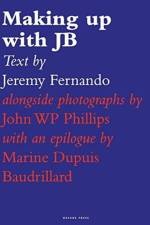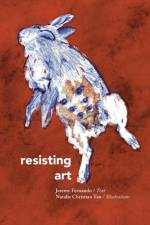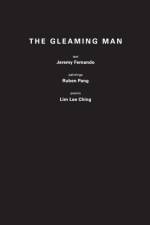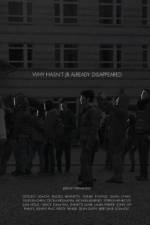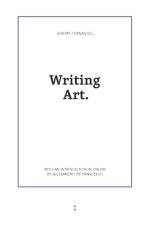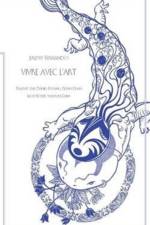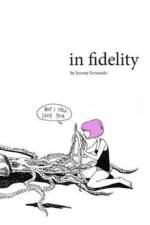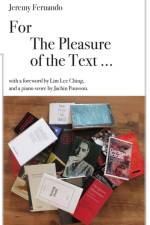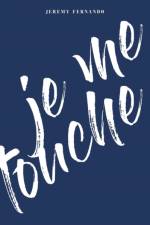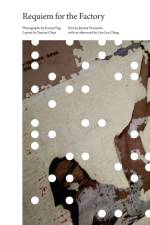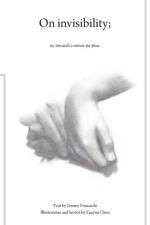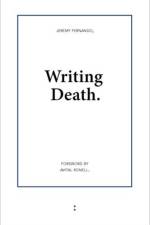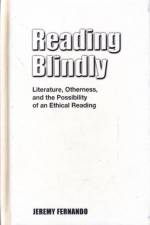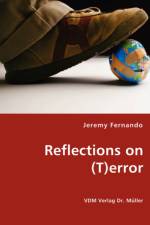Bøger af Jeremy Fernando
-
248,95 kr. It is so very frustrating, makes one almost want to scream - petulantly, childishly even - that it is a deeply unfair world when the one you most want to speak to, to be with, is the very one you can't.Particularly when calling out to you is not so much the thing I cannot do (of course one always can) but the very thing one shouldn't. For, one should try not to forget that - even as it might pain one to do so - words are missiles that explode in your somatic being.Where sending them out might cause damage, even bring ruin;and keeping them in, be catastrophic.I suppose one might say you helped send me on a path towards the beautiful, opened in me the possibility of catching a glimpse of beauty -three stepson the ladderof writhing
- Bog
- 248,95 kr.
-
243,95 kr. This text attempts to address the question, 'what is the weight of a painting?' A question that came to me not quite as a question, but as a musing. From a painter nonetheless. And perhaps more significantly, from Ng Joon Kiat, a painter who has long been questioning painting, and not just through the question of 'what is a painting', that is the materiality of what is added to, dabbed onto, plastered on, a canvas, on wood, onto aluminium, on a surface, but who is on a quest to explore 'paint' itself, on a journey of 'playing with paint'. So, a question that might never quite have been meant for me. Thus, quite possibly only a quest that I am embarking on only because I have heard it as a question, have heard it call out to me, heard its call as a question, have taken it as to be a question, have inscribed the mark of a question on it. Have made it significant because I first started marking on it, have let it weigh on me. 'What is the weight of a painting?' Which is not the same question as, 'how much does a painting weigh?' For that, all you have to do is to get a scale. But rather, a question of 'its weight': of how much it 'weighs down' - not just on you, even as that is certainly part of the question, but perhaps even on itself. And where the text opens the possibility that the image is 'the weightless weight' one encounters - is the site of a coming-together of the work and the one who stands before it, whether by sight or in the mind's eye - in the 'gap between the frame and the viewer'; and like the feather of Ma'at, is the juncture in which judgment occurs, where there is a weighing out, where the status of the work as art is quite possibly weighed up, where there is a weighing in by everyone involved, and where what is considered 'good' might well entail an absence of weight.
- Bog
- 243,95 kr.
-
248,95 kr. to drift -perchance to dream. In which one can never quite tell if a thought that comes to one came from one, had arrived onto one, or if one might have merely slid to it, drifted into it. Where, one can never quite know if one is responding to works - to the beautiful pieces brought forth by Priyageetha Dia, Anne Dufourmantelle, Gabriela Golder, Mariela Yeregui, Jacques Tati - or if one is writing onto them, speaking over them. Or, if the works might have written themselves onto me, into me, have been guiding the hand (manus) which thinks it is, have been leading the scribe who imagines he is, inscribing onto the manuscript. Where, the very notion of having a thought might well only be thought teasing one. And where, teasing out a thought always already opens one self to being teased. But perhaps we are always only - can only ever be - playing.
- Bog
- 248,95 kr.
-
493,95 kr. Our skin --all over us, inside us;multiple, divisible, same same but different; different in parts within, and all over, the same self; a multiplicity. And where, it is our scars -- that write themselves onto us, the keloids that hold us, claw us (khele) together -- which give us form (eidos). Without which, there is no possibility of even knowing (eidenai), catching a glimpse of, our very self. The skin upon which I write, upon which I writhe. Which writhes on me as I write. As I am writing skin.
- Bog
- 493,95 kr.
-
173,95 kr. - Bog
- 173,95 kr.
-
- Bog
- 183,95 kr.
-
183,95 kr. This text attempts to respond to the question of the relationship between art and resistance, to the possibility of art as resistance - that is, it is an attempt to meditate on the possible relationship between resisting and art. Whilst doing so, it also tries to attend to the notion that art is an encounter - between one and something that is brought forth in the movement from craft to something other than what is created through tekhn¿. And, if so, it is always also potentially unknown, unknowable, until it happens, perhaps even after it happens. That, even as it might be experienced, felt - an encounter through aisthesis - it is quite possibly a moment beyond cognition; un pas au-delà, as it were. And if so, then perhaps all attempts to know it potentially do nothing other than to frame, to confine, its potentiality.Thus, perhaps the very thing that one has to do - if one is to attempt to maintain the possibility of resistance in art - is to resist what one thinks art itself is.
- Bog
- 183,95 kr.
-
298,95 kr. The Gleaming Man is a conversation between the texts of Jeremy Fernando, the paintings of Ruben Pang, and the poems of Lim Lee Ching. Among other things, it is an attempt to meditate on the question of how different forms of work can speak with each other without speaking over - or, even worse, speaking for - an other. For, if art is the transformation of something that is brought forth through craft, through tekhn¿, into something else, it not only potentially lies beyond us, it might well also transform the one who looks at it. Thus, writing on art - even if one thinks one is picking up a call from the work - not only risks completely missing the point, but is quite possibly always already writing art itself. Thus, to write on art, one must open oneself to the possibility of the impossible. Which is precisely why Jeremy Fernando attempts to bring forth an impossible writing. And where alongside Lim Lee Ching's poems - keeping in mind Michel Deguy's reminder that poetry is not about seeing the invisible, nor the very visible; poetry instead is about seeing the slightly visible - the texts attempt to open us to not just what can be seen in the paintings of Ruben Pang, but what shimmers there; both within and always also slightly beyond seeing itself. But not just as words, in words - but in its sound, its musicality. And when in reading, in seeing - the paintings, the poems, the texts - it is the reader who brings them all together, in an impromptu conversation, if only for a moment.
- Bog
- 298,95 kr.
-
236,95 kr. In her lecture entitled 'Cosmopolitics: Learning to Think with Sciences, Peoples, Natures', Isabelle Stengers issues a challenge for us to rethink our relationality with the world: to move from an anthropocentric conception - one of her main critiques is the casting of Nature as a "loving mother," as if we are its offspring - to a response to, "with," the unknowability that is Nature; in its, and our, multiplicities. This book offers a reading of the notion of the mother; and, in particular, why Science relies on it. Rifting off, and with, Stengers' notion that the familial, familiar - that naming - is an attempt to tame Nature, this reading opens the possibility that Science's reliance on the correspondence between a notion and a phenomenon, for legitimacy and ultimately authority - allowing all echoes of daddy to resound here - is hinged upon the figure of the mother. However, a reading of the mother also unveils the mystical foundations of the daddy figure of Science, or at least that which Science has become. Thus, it is not so much that we need to revoke Mother Nature, or recast her as an ancient Gaia (as Stengers suggests), but that, more than ever, we need to take the notion of the mother, in all its profundity, seriously. And by doing so, we might perhaps reopen the register that Friedrich Nietzsche never quite lets us forget; that of the gay scientist - the one who tests everything, even the test itself. And in the spirit of Nietzsche, the book opens a conversation with Stengers through multiple channels: written text by Jeremy Fernando; paintings by Maureen Burdock; Mariane Klettenhofer's layout which brings both together whilst maintaining their singularities. Thus, a triptych of responses: all disparate yet always also with Stengers; quite possibly in an attempt to respond to the possibility of a community that she calls for.
- Bog
- 236,95 kr.
-
297,95 kr. This book is an attempt to respond to a text message, a textual call - to a missive sent by Tombie Rautenbach that arrived at three in the morning on 7 March 2007 - which read, « Baudrillard is dead ». But more than a eulogy, more than a mourning - if such a thing is possible - this is an attempt to think with Baudrillard, all whilst keeping in mind the fact that his work, his writing, his thought, always brings with it a little chuckle, a sly grin. So, perhaps an attempt at the impossible: thinking with a smile at a point where there might not have been much, if anything, to smile about.Trying never to forget that in attempting to speak with the dead, one always also runs the risk of rewriting them, writing over them, quite possibly effacing them. But, of course, Baudrillard already knew this: after all, he was the one who called for his own disappearance even before his death. So perhaps, this book is an imaginative response: a reading in fidelity to JB; not to the man - nothing so banal - nor even to his work; but a reading that opens itself to the possibility of the grin of the one who has already disappeared, to the shadow of his silent smile. The responses are composed of writings by Jeremy Fernando; alongside translations by Setsuko Adachi & Daniel Kwang Guan Chan; a poem by Laura Parker; art-works by Russell Bennetts, Cecília Erismann, Michael Kearney, Sorelle Henricus, Julia Hölzl, Grace Euna Kim, Jeanette Lamb, John WP Phillips, Kenny Png, Kristy Trinier, Sean Smith, and Berit Jane Soli-Holt. These conversations between - perhaps even attempted séances by - the various texts, modes of responses, were mediated by Yanyun Chen.
- Bog
- 297,95 kr.
-
215,95 kr. - Bog
- 215,95 kr.
-
228,95 kr. - Bog
- 228,95 kr.
-
305,95 kr. « … It has taken me years to admit - perhaps only to myself - that I don't care about writing something important, something significant. That my only hope, wish - dream even - is to write something beautiful … » (139) This book attempts to open the dossier of fidelity; and, in particular, attend to the question of the relationship between fidelity and its object, to the question of: must there be an object to fidelity? For, if one is faithful to something or someone, is one responding to the what, the characteristics of the thing, the person; or the who, the person, thing, as such? Which is not to say that what and who are necessarily distinguishable, separable, to begin with. However, if we open the possibility that the who is always already beyond us - outside of knowability, if even only slightly - this suggests that it is the spectre, the potential unknowability, that haunts all relationality. Thus, even if there is an object to one's fidelity - for, without which one cannot even begin to speak of fidelity, speak of relationality - this might well be an objectless object or, at least, an object that remains veiled from us. In order to explore this relationship - in which one cannot even be sure if there is a relationality; for, without the object, the nature, if one can call it that, of the relation is speculative - the text takes the form of an exploratory fiction. Where it attempts to bear witness to the possibility of fidelity - keeping in mind that fiction is both the limit to, and condition of, testimony - whilst quite possibly only testifying to the possibility of being able to testify. Nothing more.
- Bog
- 305,95 kr.
-
249,95 kr. At the heart of this book lies attempts to read: reading here being understood as theopenness to the possibility of another; a relation that occurs prior to any semantic or formal identification, and, therefore, prior to any attempt at assimilating, or appropriating, what is being read to the one who reads.Thus, an event.It opens with Lim Lee Ching's reading of this book; a reading before your reading, as it were. And is followed by Jeremy Fernando's attempts to respond to the many Roland Barthes - all whilst foregrounding the risk that, even as one attempts to read as openness to the possibility of another, all reading potentially re-writes the other; that his reading may well be an inscribing of his R.B.; that whilst reading it, you may well be making your very own R.B.. In the midst of which, you will find a piano score composed by Jachin Pousson: which is both a nod to the fact that Barthes was a pianist, and also a note to the musicality of the thought of Roland Barthes. The hope is that these readings bring, open the possibility of, pleasure: not just for the one who reads, but perhaps even for - if one allows oneself to imagine - the text. For the one we call, name - can do nothing but name - Roland Barthes.
- Bog
- 249,95 kr.
-
248,95 kr. This book is an attempt to read, to respond to, the Occupy Movement in four movements. Opening with a reading of Flann O'Brien's evocative short story, 'John Duffy's Brother', it opens the dossier of the generative powers of imagination: not just in opening possibilities in the world, but that what is brought forth is always already a world onto itself. This is followed by a reading of Hermann Melville's 'Bartleby the Scrivener', with a particular focus on the utterance, « I would prefer not to » ; not just as a phrase of negative resistance, but as a potential challenge, as a seductive challenge. The third movement is an attempt to directly respond - if such a thing is even possible - to the Occupy Movement in all of its potentiality: in no way, shape, or form, does the text attempt to explain it; instead, it attends to it in all of its possibilities, unknowabilities, absurdities even - en bref, as an event. It ends with an attempt to reflect on what it means to speak of something, especially an event - through, and alongside, the slippery figure of the subject, the « I ».
- Bog
- 248,95 kr.
-
334,95 kr. Requiem for the Factory is a conversation between two forms of writing: language, and light. This occurs in a tale that attempts to explore the relationality of a self to her self through the figure of a factory. Told through an "I" that refuses to remain stable, one isnever sure whether this is a moment when the tale is recounted, recalled, or whether it is being told at the moment of telling.And this is why this requiem has to be narrated. What is foregrounded is not only the fact that memory, history, is fictional, but more pertinently that the self-and the "I"-can only be uttered, perhaps even known, through fictionality. This is not to say that the self is imagined-unreal-but that the imaginary is in the very fabric of reality itself.This is a tale of two writings that are speaking to, and with, each other, whilst also speaking in their own realms at the very same time.
- Bog
- 334,95 kr.
-
174,95 kr. On Invisibility attempts to meditate on the relationality between the seen and unseen, known and unknowable, particularly when in relation with an other, when grappling - in touch with - another. This text opens the dossier that, whilst seemingly antonyms, invisibility is part of visibility; that each act of seeing is fraught with the possibility of blindness. And more than that, relationality with another is premised on this very unknowability. Which is why, not only does one encounter jiu-jitsu through practice, praxis; not only does one encounter jiu-jitsu through an encounter with the other; part of it always escapes us, remains enigmatic. Thus, not only is it arte suave, it is always also potentially arte bela. So, even as we attempt to address the question what is jiu-jitsu, part of it will always remain beyond us. Which might be why we have no choice but to turn to art: for, all that we know, can see, of jiu-jitsu will be fragments of it - sketches.
- Bog
- 174,95 kr.
-
219,95 kr. "Ask not for whom the bell tolls... Eulogy: one of the many English words combining legein (to gather together) and logos (the word, the law). With eulogy though the speech-act itself is all important (eu-) and its impossibility evident in a written work. The site of the gathering together of words, of scattered sounds, disappears in the act of writing, itself scatter -- all too forcefully underlining the cause, the event of dispersion that creates the need for gathering together. Jeremy FernandoΓÇÖs eulogy, this particular eulogy, is called Writing Death, and it reminds us that eulogy in its impossibility may well be the primary genre of writing. Writing and death have always gone together, hence PlatoΓÇÖs suspicions of chirographic technologies. The author is absent, as is the subject. The text brooks no questions and gives no answers. FernandoΓÇÖs gathering of scatterings in the form of mini-meditations unfolds the weaving of textus that makes writing possible and makes death comprehensible in all of its paradoxical mystery and awe-ful presence. His is a book of catalysts: use them with care.ΓÇ¥-- Ryan Bishop, Professor of Global Arts and Politics, the Winchester School of Art , the University of Southampton
- Bog
- 219,95 kr.
-
1.033,95 kr. Reading Blindly attempts to conceive of the possibility of an ethics of reading reading being understood as the relation to an other that occurs prior to any semantic or formal identification, and therefore prior to any attempt at assimilating what is being read to the one who reads. Hence, reading can no longer be understood in the classical tradition of hermeneutics as a deciphering according to an established set of rules as this would only give a minimum of correspondence, or relation, between the reader, and what is read. In fact, reading can no longer be understood as an act, since an act by necessity would impose the rules of the reader upon the structure of what (s)he encounters; in other words the reader would impose herself upon the text. Since it is neither an act nor a rule-governed operation, reading needs to be thought as an event of an encounter with an other and more precisely an other which is not the other as identified by the reader, but heterogeneous in relation to any identifying determination. Being an encounter with an undeterminable other an other who is other than other reading is hence an unconditional relation, a relation therefore to no fixed object of relation. Hence, reading can be claimed to be the ethical relation par excellence. Since reading is a pre-relational relationality, what the reader encounters, however, may only be encountered before any phenomenon: reading is hence a non-phenomenal event or even the event of the undoing of all phenomenality. This is a radical reconstitution of reading positing blindness as that which both allows reading to take place and is also its limit. As there is always an aspect of choice in reading one has to choose to remain open to the possibility of the other Reading Blindly, by extension, is also a rethinking of ethics; constantly keeping in mind the impossibility of articulating an ethics which is not prescriptive. Hence, Reading Blindly is ultimately an attempt at the impossible: to speak of reading as an event. And since this is un-theorizable lest it becomes a prescriptive theory Reading Blindly is the positing of reading as reading, through reading, where texts are read as a test site for reading itself. Ostensibly, Reading Blindly works at the intersections of literature and philosophy; and will interest readers who are concerned with either discipline. However as reading is re-constituted as a pre-relational relationality, it is also a re-thinking of communication itself a rethinking of the space between; the medium in which all communication occurs and by extension, the very possibility of communicating with each other, with another. As such, this work is, in the final gesture, a meditation on the finitude and exteriority in literature, philosophy calling into question the very possibility of correspondence, and relationality and hence knowledge itself. For all that can be posited is that reading first and foremost is an acknowledgement that the text is ultimately unknowable; where reading is positing, and which exposes itself to nothing and is in fidelity to nothing but the possibility of reading.
- Bog
- 1.033,95 kr.
-
527,95 kr. - Bog
- 527,95 kr.

